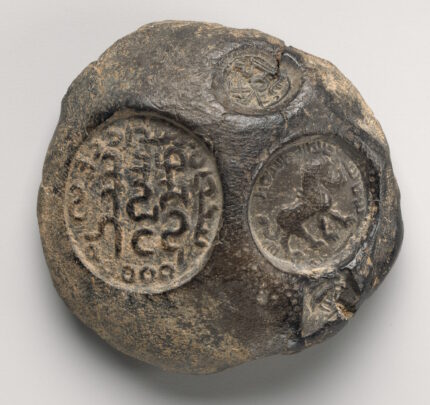 The name of the Iranian city of Shiraz has been identified on a 7th century Sasanian clay seal discovered almost 100 years ago at Qasr-i Abu Nasr in southern Iran. The clay was impressed with four seals: a lion walking right, a monogram, an inscription in Pahlavi script (Middle Persian) and a horned animal. Iranian archaeologist Mohammadreza Nasab-Abdollahi has now deciphered the name “Mugh-e Shiraz” in the Pahlavi inscription.
The name of the Iranian city of Shiraz has been identified on a 7th century Sasanian clay seal discovered almost 100 years ago at Qasr-i Abu Nasr in southern Iran. The clay was impressed with four seals: a lion walking right, a monogram, an inscription in Pahlavi script (Middle Persian) and a horned animal. Iranian archaeologist Mohammadreza Nasab-Abdollahi has now deciphered the name “Mugh-e Shiraz” in the Pahlavi inscription.
Sasanian clay seals were lumps of clay of different shapes and sizes used as official administrative stamps. The wet clay was wrapped around the tie of a document or bundle of goods and then stamped with the relevant seal or, as in this case, seals. The dried clay seals would on some occasions be broken and removed and deliberately stored for administrative purposes. This seal was unearthed by Metropolitan Museum of Art archaeologists in excavations at the Late Sasanian fortress at Qasr-i Abu Nasr site between 1932 to 1935. It was one of more than 500 stored seals discovered in a building that had been burned down, firing the clay seals and preserving their impressions for centuries.
Located four miles east of Shiraz, Qasr-i Abu Nasr was occupied in stages starting in the Parthian period (247 B.C. – 224 A.D.). The Sasanian period of occupation (224-651 A.D.) was the major phase of construction of the fortress, but while it was strategically located with access to water along roads to the Shiraz plain, the population remained small.
According to Nasab-Abdollahi, archaeological investigations indicate that Qasr-e Abu Nasr in Shiraz exhibits a cultural sequence from the Achaemenid to the Abbasid period, with its primary settlement dating back to the Sassanid era.
“The archaeological findings from Qasr-e Abu Nasr reveal a wide spectrum of administrative systems, techniques, and defensive structures,” the archaeologist remarked.
Furthermore, he emphasized that archaeological evidence from the Sassanid period, including such clay sealings, as well as artifacts from the Achaemenid era such as inscribed bricks from Persepolis, corroborates that the city known today as Shiraz bore the same name in antiquity and was among the significant cities of ancient Iran.